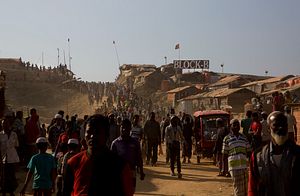March 23, 2018 marked two months since the first wave of repatriation of Rohingya refugees in Bangladesh was to begin through a bilateral agreement with Myanmar signed in November 2017.
Since then, not a single refugee — of the 6,88,000 new arrivals — has been returned to northern Rakhine state, from where they fled after Myanmar security forces began a violent “counterinsurgency” campaign in August 2017. As of March 2018, the Myanmar government has verified only 374 refugees for repatriation, out of the 8,032 names that Dhaka had sent across for the first phase.
There are several restraining factors that make full repatriation not just difficult under prevailing circumstances, but impossible.
Northern Rakhine’s Changing Landscape
In a March report, Amnesty International — using detailed satellite imagery — revealed the rapid construction of new infrastructure by Myanmar’s security forces on top of Rohingya villages that were razed to the ground after August 2017 and later bulldozed. The new structures include at least three military bases in Maungdaw and Buthidaung townships, helipads, fencing, roads, extensions of non-Rohingya (also known as “NaTaLa”) villages, and even a refugee processing center.
The international community, in response to these new construction activities, has accused Naypyidaw of obliterating material evidence of mass killings that the Myanmar military stands accused of. The logic behind the construction, however, seems to be the permanent alteration of the northern Rakhine landscape to facilitate deeper military presence and prevent any reversal to the pre-August 2017 status quo. The new security infrastructure will also serve as a deterrent to current and future Rohingya insurgencies.
Notably, the new landscaping makes it highly difficult for the displaced to return, as the bilateral repatriation agreement stipulates, to their “own households and original places of residence.” The new installations also preclude reconstruction of burnt Rohingya villages, thus making long-term rehabilitation unviable.
A large part of the new construction is being done under Myanmar’s centralized plan to redevelop Rakhine state to strengthen the state’s economy. Hence, the landscaping falls within a quasi-legitimate, sovereign context of economic development, which was also prescribed in the Kofi Annan Commission’s report on Rakhine.
Myanmar-Bangladesh Bilateral Tensions
The safe, dignified, and voluntary repatriation of Rohingya refugees cannot take place without total cooperation and understanding between Myanmar and Bangladesh. However, both parties seem to be nearing a zero-sum game.
Earlier in March, Myanmar began deploying heavily armed troops along a section of its border with Bangladesh that lies next to a “no man’s land,” where close to 1,500 Rohingya have been trapped since August 2017. This led to Dhaka’s fears of military aggression by Myanmar despite the latter’s assurance that the deployment was purely along counterinsurgency lines.
Thereafter, both sides have exchanged hostile rhetoric several times: Bangladesh’s finance minister has called the Myanmar government “evil” and “rogue,” and Myanmar has accused Bangladesh of flouting the bilateral agreement during verification of potential returnees. While Bangladesh doubts Myanmar’s willingness to take back the Rohingya, the latter insists that Dhaka is not serious about the process.
Myanmar’s steady militarization of the border, including laying landmines and advance surveillance equipment, is a clear indication of Naypyidaw’s intent to keep a bulk of the displaced Rohingya out of its territory. To this end, “counterinsurgency” and “preservation of territorial sovereignty” are convenient smokescreens toward the achievement of a militarized buffer zone between Myanmar and Bangladesh. The strengthened border security also complements the upgraded military infrastructure in the hinterlands to create an overwhelming military dominance in northern Rakhine.
A Prognosis
Will the Rohingya refugees in Bangladesh ever return to Myanmar? There is no clear answer, but given the strong international pressure on Myanmar, and the bilateral agreement, a part of the displaced population may be taken back in the near future.
However, the repatriation process is going to be heavily controlled. Since the decision of whom to take back lies with the Myanmarese authorities, the narrow citizenship verification norms (from the 1982 Citizenship Law) that reject the Rohingya identity and instead impose temporary citizenship status are expected to govern the return process.
Furthermore, it remains impossible to know how long the returnees will be housed in the “temporary” resettlement camps; the aftermath of the 2012 violence shows that they could remain there for years. All of this renders the repatriation process unsustainable, and the returnees vulnerable to future displacements.
The limited repatriation expected could also fail tests of safety and voluntarism. Given the instability in Rakhine and anti-Rohingya polarization, there is no guarantee of safety for the returnees. According to the UN, more than 77 percent of refugees feel they do not have enough information to make good decisions — which means the absence of voluntary consent for repatriation.
Dhaka clearly understands the reality of a prolonged repatriation process and has thus been redeveloping a remote island off its southern coast to relocate some of the refugees from the existing camps in Cox’s Bazar. This could ease pressure on mainland resources and ensure that the refugees are cut off from the mainland populations, to negate security threats that may arise. This, however, may be not a sustainable plan given the drastic impact of seasonal cyclonic storms and floods on these remote islands.
The situation, as of now, is bleak. Full repatriation may take at least two to three years, and that too as a best case scenario.
Angshuman Choudhury is a New Delhi-based policy analyst, currently coordinating the Southeast Asia Research Programme at the Institute of Peace and Conflict Studies (IPCS).
This piece was originally published by the Institute of Peace and Conflict Studies.

































